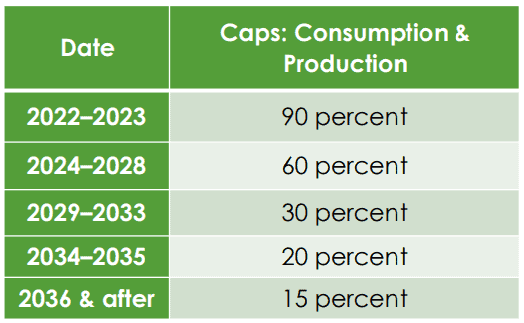AIM: EPA’s HFC Authority Is On!
The Aim Act
By Steve Schaeber, MACS Technical Editor
This is the biggest news to hit our industry since the Clean Air Act phased out R-12 in 1990 and it has the EPA working at full speed.
On December 27, 2020, President Trump signed into law the Consolidated Appropriations Act, which at $2.3 trillion is one of the largest spending bills in US history. It combines $600 billion in COVID relief with $1.4 trillion in twelve different appropriations bills. One of them is the AIM Act.
AIM stands for the American Innovation and Manufacturing Act, which establishes three main types of regulatory programs for EPA: 1) The economy-wide phasedown of the production and consumption of listed HFCs (hydrofluorocarbons), 2) The transition to next-generation technologies by sector, and 3) The management of listed HFCs. For MACS members, this means R-134a.
After years of back and forth court battles over EPA’s 2015 and 2016 HFC regulations (which they basically lost), EPA finally has the statutory authority they need to regulate HFCs (like R-134a) in the same way that they regulate ODS (ozone depleting substances) like R-12.
There are certain provisions of AIM which are similar to Title 6 of the Clean Air Act (one of which is Section 609), but there are clear differences between the two. The AIM Act is a separate authority for EPA, and it includes a state preemption clause which basically overrides certain existing state laws.
For the refrigerant phasedown, EPA has a deadline of September 23, 2021 to issue a final rule on an allocation program. Then, by October 1st of each year, they will allocate HFC allowances for the following year. AIM specifies a phasedown calculation (based on 2011-2013 production and consumption), which starts with a 10% reduction in 2022, and increases to 85% by 2036.
See chart below:

In transitioning to new technologies, EPA has been authorized to restrict the use of HFCs on a sector-by-sector basis. While nothing is in the works right now, it is possible that EPA could restrict the use of R-134a in MVAC (similar to their failed MY2021 rule), which would help facilitate our industry’s transition to R-1234yf. It’s unclear whether this will happen (since by our calculations about 85% of new vehicles being manufactured today already use yf), but they have the authority to do that, should they choose. Either way, we don’t think EPA would restrict the use of R-134a for servicing the existing vehicle fleet, considering that retrofitting to R-1234yf is not allowed.
As for the management of HFCs, this speaks to another regulation that was shot down by the courts, focusing mainly on calculating and repairing leaks on commercial refrigeration (like those GIANT A/C systems and refrigerators at the big box stores). Of course, there’s always a possibility that MVAC could be included in their program. MVAC is the third largest source, accounting for 13% of global HFC emissions.
Probably of most interest to shop owners, is that AIM provides for a targeted small business technology grant, for the purchase of approved refrigerant recycling equipment. This is the only place in the 2,124 page law which specifically calls out, “the service or repair of motor vehicle air conditioning systems”. The program hasn’t yet been put together, and it is subject to appropriations, but it does provide for limited matching funds of $5,000,000 for each of the fiscal years 2021 through 2023. So, keep this in mind if you have an R-1234yf machine that you’ve been thinking about!
Of course, there’s so much more to AIM than I can cover in my Service Port column, and EPA is going to be super busy with putting everything together. So, stay tuned. We’ll have LOTS of news to tell you about over the next several months.
Plus, we’re looking forward to our next major update from EPA at MACS 2021 in Orlando.
Hope to see you there!
Leave a Reply